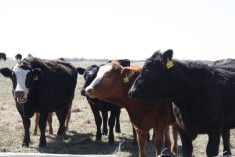This cattle market information is selected from the weekly report from Canfax, a division of the Canadian Cattle Association. More market information, analysis and statistics are available by becoming a Canfax subscriber by calling 403-275-5110 or at www.canfax.ca.
Tight fed supplies
Fed cattle are working through tight supplies. Prices rallied $13 per hundredweight over the past month but are showing signs of levelling off.
Despite record high western Canadian fed prices and strong basis levels, fed cattle shipments to the United States remain historically large. Weekly exports of fed cattle and cows averaged more than 14,000 head, up 26 per cent from last year.
Read Also

Defence investments could benefit agriculture
A bump in Canada’s NATO spending commitments could lead to infrastructure investments that would benefit rural areas
Competition on the cash market was good with all three western Canadian packers buying. Last week, there was a mix of fed calves and yearlings on offer with no price difference between the two. Dressed sales were reported from $430-$432 per cwt. delivered.
After trading sideways for the past 10 weeks, Ontario prices have started to move higher. Last week, dressed sales were at $407 per cwt. delivered, $7 per cwt. higher than the previous week. For the week ending April 20, eastern Canadian steer weights averaged 997 pounds, one lb. shy of record highs set in May 2021.
In the U.S., sales in Iowa and Nebraska ranged from $292-$295 per cwt., steady to $3 per cwt. higher than the previous week. Live sales in the northern feeding states were $184-$187 per cwt. (mostly $185 per cwt.), $2 per cwt. stronger.
Sales in Texas and Kansas ranged from $182-$184 per cwt., steady to $2 per cwt. higher. For the week ending April 6, heifer slaughter totalled 212,000 head, the largest weekly slaughter since December 2007. U.S. steer drop credit values are drifting down and are currently at the lowest point since April 2021.
Strong cow rally
Alberta D2 cow prices remained steady last week at $178.83 per cwt., up $32.58 per cwt. from last year. Ontario D2s traded at $155.06 per cwt. Having put in a $57 per cwt. rally since the start of the year, this is the strongest rally historically. Alberta D3 cows traded at $163.98 per cwt., while Ontario D3s were $132.48 per cwt.
Looking at the five-year average, D2 cow prices typically peak in late May, with solid support as spring and grills heat up. Butcher bulls reached a new record high at $193.24 per cwt., up $37.39 per cwt. compared to last year, having put in a $51 per cwt. rally since the start of the year.
For the week ending April 20, Canadian non-fed slaughter totalled 8,334 head, up a slight two per cent from the previous week. Year-to-date, non-fed slaughter, at 157,724 head, is down 7.1 per cent from last year.
Feeders look strong
Feeders rebounded last week, with Alberta steers under 700 lb. trading $3-$8 per cwt. higher than the previous week, and 700-900 lb steers trading steady to $2 per cwt. higher. Only heavyweight 900 lb. and heavier steers traded $1 per cwt. lower at $302.50 per cwt.
Alberta medium weight 500-900 lb. heifers traded $3-$6 per cwt. stronger than the previous week. Notably, 300-500 lb. and 900 lb. heifers had the strongest rally, up $10-11 per cwt.
Overall, this year’s price rally has been stronger, except for 500-600 lb. heifers, where last year saw a $3.09 per cwt. stronger rally. Futures for May have been gradually climbing back toward $250 per cwt. from the low of $234 per cwt. reported in the second week of April.
For the week ending April 13, feeder cattle exports to the U.S. totalled 4,038 head, 18 per cent below the same week last year. Year-to-date, feeder exports reached 40,977 head, up six per cent from last year. Exports from the West are down 7.3 per cent from last year at 26,739 head, while exports from the East nearly doubled, up 42.6 per cent from last year to 14,238 head.
U.S. cutouts steady
Cutouts stayed in place last week, at $296-297 per cwt., even as most fundamentals remain price supportive. Choice and Prime beef production is down two per cent year to date on reduced fed slaughter (negative three per cent). Heavier fed carcasses (plus per cent YTD) have been supporting grading quality, with carcasses grading either Choice or Prime steady with last year at 84 per cent of all graded carcasses.
Between mid-March and mid-April (five weeks), carcasses grading Choice or Prime averaged 84.6 per cent, almost one higher percent than the same period last year.
The recent bump in grading quality may have taken some of the wind out of the sails of Choice cutouts in April. Choice cutouts closed the week at $295.66 per cwt., with Select at $288.41 per cwt. Load counts were up 15 per cent to 658 loads.














